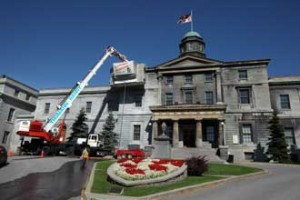
By Pascal Zamprelli
Two of McGill University’s most iconic buildings are getting a major makeover this summer.
For the first time since their construction, the front facades of McGill’s Arts Building and Strathcona Music Building will be thoroughly cleaned, erasing decades of grime and making it easier to repair and restore the limestone with which they are built.
Following a public tendering process in May, the French company Thomann-Hanry Inc. was chosen for the project, primarily because of the unique, environmentally friendly technique it employs. Known as “gommage,” the cleaning method involves no sandblasting or pressure of any kind that might damage the aged stone.
“We felt that the only technique that would work was a system that uses a micro-abrasive tool that applies very little pressure with silica,” explained Carlo Cimo, Senior Project Manager with McGill’s Facilities Operations and Development. “It’s actually sucking out the dirt, almost like a vacuum cleaner. That’s gommage.”
Originally, the buildings were slated for a massive masonry repair and restoration effort over the summer. But Cimo suggested they first clean the facades, which not only beautifies the structures but will make the restoration easier as well.
“Now, seeing the actual natural colour of the limestone and the condition of the stone, we can see all the defects as well. This way, when we prepare for restoration or repairs of the masonry, we have clear-cut picture of what’s involved,” he said. “This limestone, which is a natural stone found here in Quebec, is a beautiful stone that we’re now bringing back to its original authenticity.
The cleaning of the Arts building is currently under way and will be completed on July 17, while the cleaning of the Strathcona Music Building will begin Aug. 3 and will take approximately three weeks to complete.
McGill’s first classes were held in 1829 in Burnside Place, James McGill’s country home, but the institution’s needs soon outgrew that location. The Arts Building, for which construction began in 1839 and was completed four years later, represented the first structure built specifically for McGill University (then called McGill College). The building’s opening marked the establishment of McGill’s Faculty of Arts, and the iconic structure still anchors the downtown campus today.
The Strathcona Music Building, which today is one of the homes of McGill’s Schulich School of Music, was erected in 1899 to house the Royal Victoria College, the building’s original name. In 1888, women were able for the first time to enroll on a full-time basis and the structure was built to serve as a women’s dormitory and educational facility. In 1971, much of the building was given to the Faculty of Music, and was renamed in honor of Lord Strathcona (Donald Alexander Smith), who had been instrumental both in financing the building’s construction, and in first funding education for women at McGill. The West wing of the building remains the Royal Victoria College Residence.
